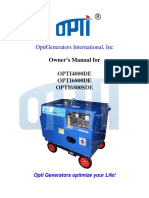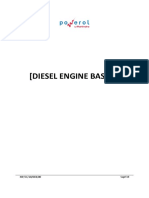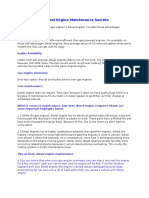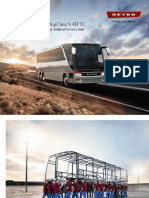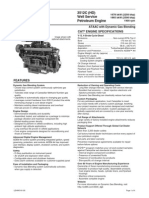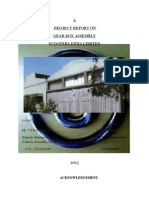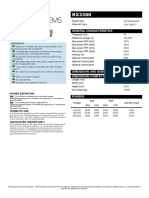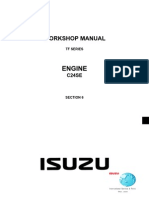Cooling System
Cooling System
Uploaded by
Ankit OmarCopyright:
Available Formats
Cooling System
Cooling System
Uploaded by
Ankit OmarOriginal Description:
Copyright
Available Formats
Share this document
Did you find this document useful?
Is this content inappropriate?
Copyright:
Available Formats
Cooling System
Cooling System
Uploaded by
Ankit OmarCopyright:
Available Formats
Heavy-Duty Diesel Engine Cooling
Systems
Tom McKinley
Cummins, Inc.
Objectives
Provide background information useful to tomorrows lab
project (Evaluation of a Water Cooled Exhaust Manifold).
Topics covered:
Typical heavy-duty (HD) diesel engine designs
Common HD automotive diesel applications
Introduction to engine cooling systems
Arrangement
Development Tools
Design Constraints
Typical HD Diesel Engine Design
10 to 15 liters displacement
Inline-six
Turbocharged
Air-to-Air Aftercooling
300-600 hp at 1600-2100 rpm
1250-2000 lb-ft Max Torque at 1200
rpm
Dry weight 2000-2800 lb
Reliability/Durability
250,000 mile/2 year base
warranty
500,000 mile/5 year extended
warranty
1,000,000 mile life expectation
Typical HD Diesel Engine
Application
80,0000 lb GVW
100,000 to 150,000 miles per
year
6 MPG
Operating range from sea level to
>8,000 ft altitude
Ambient temperatures from below
zero to 115 deg F
Typical HD Diesel Engine Duty
Cycle
Average load of 180-200 hp
Most of fuel used at cruise rpm
of 1400-1700 rpm
Varying load at cruise due to
operation of cruise control
Varying engine speed due to road
speed changes in traffic or urban
operation
HD Truck - Percent Time by
Speed/Load
0
200
400
600
800
1000
1200
1400
1600
1800
2000
1000 1200 1400 1600 1800 2000 2200
Engine Speed (rpm)
B
r
a
k
e
T
o
r
q
u
e
(
l
b
-
f
t
)
Thermo-Fluid Systems on HD
Diesel Engines
Cooling System
Air Handling System
Lube System
Fuel System
Qhead
+
Qblock
Engine Cooling System Layout
CYLINDER LINER / HEAD LOWER WATER MANIFOLD
Water Pump
T-STAT
R
A
D
I
A
T
O
R
B
Y
P
A
S
S
HEAD UPPER WATER MANIFOLD
OIL COOLERS
Qoil
Qmnf
Qrad
Wpump
Functions of the Cooling System
To prevent excessively high and low engine component
temperatures
To provide a heat sink for the lube system
To reject engine heat to the ambient
To provide a heat source for the truck cab
To provide a coolant source for other OEM equipment
(e.g. torque converter coolers, fuel heaters)
The optimal cooling system meets system requirements while
minimizing life cycle cost (initial cost, warranty/reliability,
operating/fuel cost). Tomorrows lab will give you the opportunity
to evaluate designs from a life cycle cost perspective.
Design Control Responsibilities
Water Pump
Oil Cooler
Liners
Heads
Water Manifold/Water Header
Thermostat
Bypass
Radiator
Charge Air Cooler
Freon Condenser
Radiator Fan
Fan Drive (Drive Ratio, Fan
Clutch)
Fan Shroud
Air Dams
Cab Heater
Auxiliary Coolers
Engine Manufacturer Truck Manufacturer
Cooling System Development
Techniques
Water Pump Performance Testing
Engine Flow Stand
Flow Bench
Flow Circuit Simulation
CFD Analysis
FE Analysis
Thermal Mapping Test
Oil Cooler Performance Testing
Chassis Dyno
Cooling System Constraints
Constraint
W
P
T
e
s
t
F
l
o
w
S
t
a
n
d
C
h
a
s
s
i
s
D
y
n
o
O
i
l
C
o
o
l
e
r
T
e
s
t
F
l
o
w
B
e
n
c
h
F
l
o
w
C
i
r
c
u
i
t
S
i
m
l
C
F
D
F
E
T
h
e
r
m
a
l
M
a
p
T
e
s
t
WP Cavitation X X
WP Seal Temp X X
Max Oil Temp X X X X X X
Max Coolant Temp X
Max Component Temps X X X
Film Boiling X X X X X
Aluminum Erosion/Corrosion X X X X X
Parasitic Power X X X X X X
Water Pump Performance Test
Used to determine:
Pump capacity (flow rate) as
a function of pressure rise
and pump speed
Pump efficiency and parasitic
power
NPSH and cavitation
temperature
Water Pump Cavitation
What is It?
The formation of vapor at the pump inlet due to local pressures
dropping below the saturation pressure.
When does it Occur?
High coolant temperatures (high saturation pressure)
High coolant flow rate (low local static pressure)
Why is it Important?
Leads to a reduction of pump flow rate, therefore lower radiator
effectiveness, therefore higher coolant temps, therefore more
cavitation (runaway coolant temperatures)
Leads to an increase in water pump seal temperature (fails the
seal)
Theoretically can lead to erosion of the impeller but generally
the failure modes listed above occur first.
Typical Water Pump Map
0
5
10
15
20
25
30
35
40
0 25 50 75 100 125 150 175 200
Flow Rate (gpm)
S
t
a
t
i
c
-
t
o
-
S
t
a
t
i
c
H
e
a
d
R
i
s
e
(
p
s
i
)
4000 rpm
3429 rpm
2858 rpm
2286 rpm
1714 rpm
1143 rpm
0.00
0.05
0.10
0.15
0.20
0.25
0.30
0.35
0.40
0.45
0.50
0.55
0.60
0.65
0 25 50 75 100 125 150 175 200
Flow Rate (gpm)
T
o
t
a
l
-
t
o
-
S
t
a
t
i
c
E
f
f
i
c
i
e
n
c
y
4000 rpm
3429 rpm
2858 rpm
2286 rpm
1714 rpm
1143 rpm
Engine Flow Stand
Used to determine:
Radiator flow rate vs
radiator restriction
Coolant pressure
distribution within
engine
Coolant flow rate
through external
components
Allows estimation of
coolant flow distribution
within engine using flow
circuit modeling
1
2
3
4 5
6
7 8
17
21
22
23
24
25
Engine Restriction Curve Overlay
on Pump Map
0
5
10
15
20
25
30
35
40
0 25 50 75 100 125 150 175 200
Flow Rate (gpm)
S
t
a
t
i
c
-
t
o
-
S
t
a
t
i
c
H
e
a
d
R
i
s
e
(
p
s
i
)
DP is proportional to the
square of the flow rate
(energy equation -> DP
is proportional to V
squared)
Pump head rise is
proportional to the
square of the pump
speed
Flow rate is linear with
engine speed
Flow Bench
Used to determine:
Component coolant flow vs
pressure drop relationship
(hydraulic resistance)
On-engine component
coolant flow rates and
parasitic power using flow
circuit simulation or flow
stand testing
Hydraulic Resistance:
Analogy to Electrical Circuits
Q
Q
P
A
K
K V
T
T
|
|
.
|
\
|
= = A
2
2
2
2
1
Geometric Elements
Resistive Elements
Both equations are of the form:
Note that voltage (v) is analogous to pressure drop,
and current (i) is analogous to volumetric flow rate.
Hydraulic resistance is a function of the flow rate. Because of
this non-linearity, iteration is needed to obtain hydraulic circuit
solutions.
ri v =
Q R R P
Q Q
N N
|
.
|
\
|
= = A
1
Flow Circuit Simulation
Based on the analogy of
hydraulic and electrical circuits
Used to determine:
Cooling system parasitic
power by component and
for the entire system
Coolant flow distribution
within the engine
Approximate coolant
velocity
Assists the design effort by
allowing the design to be
iterated quickly before hardware
is procured.
CYLINDER LINERS / HEADS
R
A
D
I
A
T
O
R
PUMP
OIL
COOLER
T-STAT
WATER MANIFOLD
CFD Analysis
Used to determine
Coolant pressure drop
for use in flow circuit
modeling
Velocity distribution
Coolant side boundary
conditions (temperature
and heat transfer
coefficient) for thermal
FE analysis
Model predictions are
validated by thermal
mapping, flow bench
testing, and flow
visualization.
FE Analysis
Used to determine
Component temperatures
Component stresses
Fatigue life
Model calibrated to thermal
mapping engine
measurements
Thermal Mapping Test
Used to calibrate thermal FE
models
Oil Cooler Performance Test
Used to determine:
Oil cooler heat transfer rate
as a function of oil flow,
coolant flow, and fluid
temperatures
Oil cooler coolant and oil side
restriction
On-engine oil cooler coolant
flow rates and parasitic
power using flow circuit
simulation or on-engine
testing
0
100
200
300
400
500
600
700
800
900
10 15 20 25 30
Oil Flow (GPM)
U
A
(
B
t
u
/
m
i
n
-
4
0
d
e
g
F
I
T
D
)
25 GPM Coolant
20 GPM Coolant
15 GPM Coolant
Truck Cooling Package Layout
Air
Air at
Fan Blast
Temp
C
O
N
D
E
N
S
E
R
C
A
C
R
A
D
I
A
T
O
R
Ram Air at
Ambient
Temp
Air
Freon from
Truck AC
System
Charge Air
from
Turbo
Coolant from
Engine Tstat
Freon to
Truck AC
System
Charge Air
to
Intake Mnf
Coolant to
Engine Wtr
Pump
Note: Tomorrows lab includes optimization of a truck cooling package
Chassis Dyno Facility
Used to determine coolant
temperatures and engine heat
rejection under simulated hot
ambient conditions
Capable of handling the largest
HD trucks and engines
5 foot by 7 foot air tunnel can
provide up to 35 MPH ram air
into radiator
Mixing ambient air with
recirculated air allows the air
temperature into the radiator to
be varied to limiting ambient
conditions (100-115 deg F)
Chassis Dyno Schematic
ROOF
Dyno Rollers
Diffuser exit
OUTSIDE
External
Vertical
Louvers
Internal Horizontal
Louvers
Air Flow
Vertical Exhaust Louver
Cover Grates
Blower
GARAGE
DOOR
Summary
Cooling system design requires the optimization of components and
the system as whole to meet competing objectives of:
Initial Cost
Warranty/reliability
Operating/fuel cost
Cooling system components are under the design control of both
the engine and truck manufacturer. Cooperation is needed to
deliver the best product to the end user.
You might also like
- CASE 440, 440CT Series 3 Skid Steer Loader Service Repair Manual PDF17% (6)CASE 440, 440CT Series 3 Skid Steer Loader Service Repair Manual PDF29 pages
- Manual Hyundai r290lc7 Hydraulic Excavator Monitoring System Cluster Check Monitor Panel Functions Symbols Display PDF100% (13)Manual Hyundai r290lc7 Hydraulic Excavator Monitoring System Cluster Check Monitor Panel Functions Symbols Display PDF24 pages
- Parts For DT466E and DT530 International EnginesNo ratings yetParts For DT466E and DT530 International Engines2 pages
- OPTI 4000 6800 DE SDE - Usersmanual - PDGNo ratings yetOPTI 4000 6800 DE SDE - Usersmanual - PDG64 pages
- B875 GLP20-35VX, GDP20-35VX - (05-2005)No ratings yetB875 GLP20-35VX, GDP20-35VX - (05-2005)572 pages
- 2014 Land Rover Owners International Magazine's Range Rover P38 Buyers Guide.100% (2)2014 Land Rover Owners International Magazine's Range Rover P38 Buyers Guide.6 pages
- SPB 25 Coolant Specification and MaintenanceNo ratings yetSPB 25 Coolant Specification and Maintenance6 pages
- Exhaust Emission Reduction Technologies For Diesel Engines: Pankaj Gupta 142116517 Stress and VibrationNo ratings yetExhaust Emission Reduction Technologies For Diesel Engines: Pankaj Gupta 142116517 Stress and Vibration25 pages
- Cartridges of The World A Complete Illustrated Reference For More Than 1 500 Cartridges 13th Edition Barnes All Chapter Instant Download100% (10)Cartridges of The World A Complete Illustrated Reference For More Than 1 500 Cartridges 13th Edition Barnes All Chapter Instant Download70 pages
- The New Delphi Injector Family - Architecture and PerformanceNo ratings yetThe New Delphi Injector Family - Architecture and Performance17 pages
- Additions, Revisions, or Updates: Subject Date100% (1)Additions, Revisions, or Updates: Subject Date5 pages
- Application Requirments For OFS TransmissionNo ratings yetApplication Requirments For OFS Transmission13 pages
- Model 220 Engine Aftertreatment Systems 2013 PDF100% (1)Model 220 Engine Aftertreatment Systems 2013 PDF44 pages
- Top Ten Basic Diesel Engine Maintenance SecretsNo ratings yetTop Ten Basic Diesel Engine Maintenance Secrets20 pages
- Operation & Maintenance Manual: Compressor Model Xp185Wir P260WirNo ratings yetOperation & Maintenance Manual: Compressor Model Xp185Wir P260Wir85 pages
- Alpha LPW LPWS LPWX Engines Operators HandbookNo ratings yetAlpha LPW LPWS LPWX Engines Operators Handbook48 pages
- Vortec 8.1L: POWERTRAIN Industrial EnginesNo ratings yetVortec 8.1L: POWERTRAIN Industrial Engines2 pages
- Understanding The Mack MP8 - Engine Builder MagazineNo ratings yetUnderstanding The Mack MP8 - Engine Builder Magazine5 pages
- American Truck Simulator Engine Torque and Power CurvesNo ratings yetAmerican Truck Simulator Engine Torque and Power Curves1 page
- Control of DC Motor Using Different Control StrategiesFrom EverandControl of DC Motor Using Different Control StrategiesNo ratings yet
- A Project Report On Gear Box Assembly Scooters India LimitedNo ratings yetA Project Report On Gear Box Assembly Scooters India Limited5 pages
- A Presentation On Steering System & Geometry: by Sourabh Joshi100% (1)A Presentation On Steering System & Geometry: by Sourabh Joshi13 pages
- Safety: Wheel Loader - Generation 2 General SpecificationsNo ratings yetSafety: Wheel Loader - Generation 2 General Specifications3 pages
- PEGJ0042-02 - Caterpillar Quick Reference Guide100% (2)PEGJ0042-02 - Caterpillar Quick Reference Guide15 pages
- Volume 7 - Gas Turbine Lubrication Oil System GED00372668No ratings yetVolume 7 - Gas Turbine Lubrication Oil System GED0037266816 pages
- JOHN DEERE (Hydrostatic System - 750C, 850C Operation TM1588)100% (2)JOHN DEERE (Hydrostatic System - 750C, 850C Operation TM1588)148 pages
- CASE 440, 440CT Series 3 Skid Steer Loader Service Repair Manual PDFCASE 440, 440CT Series 3 Skid Steer Loader Service Repair Manual PDF
- Manual Hyundai r290lc7 Hydraulic Excavator Monitoring System Cluster Check Monitor Panel Functions Symbols Display PDFManual Hyundai r290lc7 Hydraulic Excavator Monitoring System Cluster Check Monitor Panel Functions Symbols Display PDF
- 2014 Land Rover Owners International Magazine's Range Rover P38 Buyers Guide.2014 Land Rover Owners International Magazine's Range Rover P38 Buyers Guide.
- Exhaust Emission Reduction Technologies For Diesel Engines: Pankaj Gupta 142116517 Stress and VibrationExhaust Emission Reduction Technologies For Diesel Engines: Pankaj Gupta 142116517 Stress and Vibration
- Cartridges of The World A Complete Illustrated Reference For More Than 1 500 Cartridges 13th Edition Barnes All Chapter Instant DownloadCartridges of The World A Complete Illustrated Reference For More Than 1 500 Cartridges 13th Edition Barnes All Chapter Instant Download
- The New Delphi Injector Family - Architecture and PerformanceThe New Delphi Injector Family - Architecture and Performance
- Operation & Maintenance Manual: Compressor Model Xp185Wir P260WirOperation & Maintenance Manual: Compressor Model Xp185Wir P260Wir
- Understanding The Mack MP8 - Engine Builder MagazineUnderstanding The Mack MP8 - Engine Builder Magazine
- American Truck Simulator Engine Torque and Power CurvesAmerican Truck Simulator Engine Torque and Power Curves
- Control of DC Motor Using Different Control StrategiesFrom EverandControl of DC Motor Using Different Control Strategies
- A Project Report On Gear Box Assembly Scooters India LimitedA Project Report On Gear Box Assembly Scooters India Limited
- A Presentation On Steering System & Geometry: by Sourabh JoshiA Presentation On Steering System & Geometry: by Sourabh Joshi
- Safety: Wheel Loader - Generation 2 General SpecificationsSafety: Wheel Loader - Generation 2 General Specifications
- Volume 7 - Gas Turbine Lubrication Oil System GED00372668Volume 7 - Gas Turbine Lubrication Oil System GED00372668
- JOHN DEERE (Hydrostatic System - 750C, 850C Operation TM1588)JOHN DEERE (Hydrostatic System - 750C, 850C Operation TM1588)



